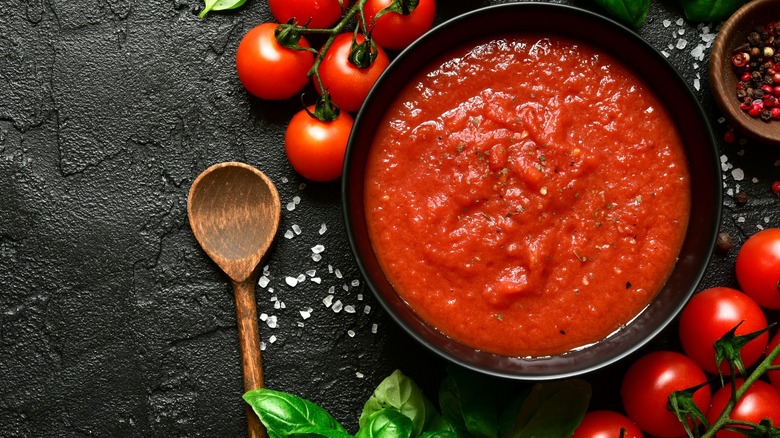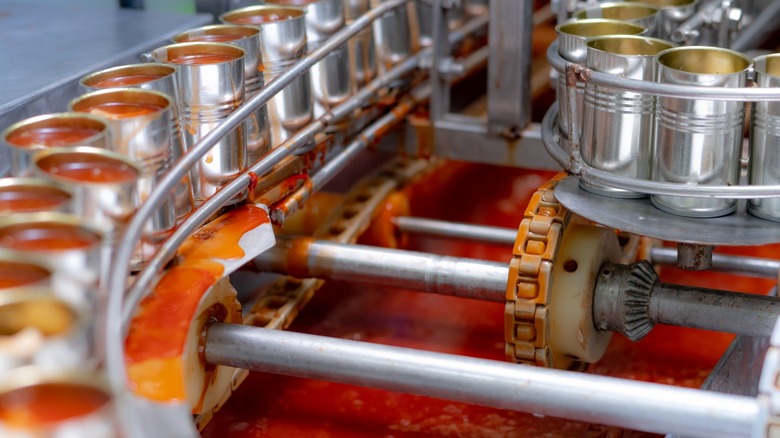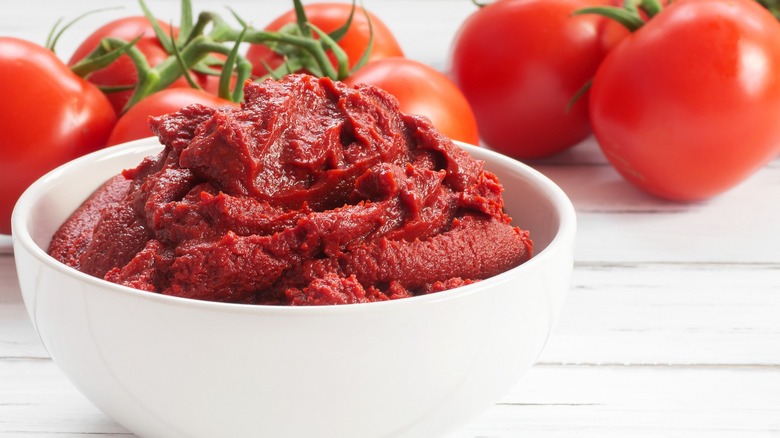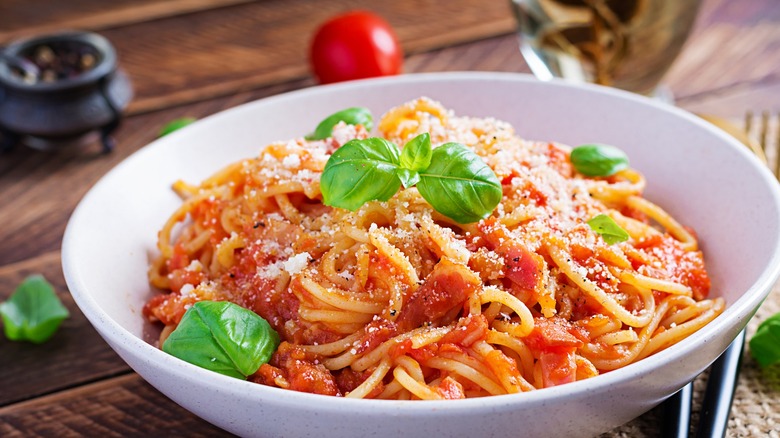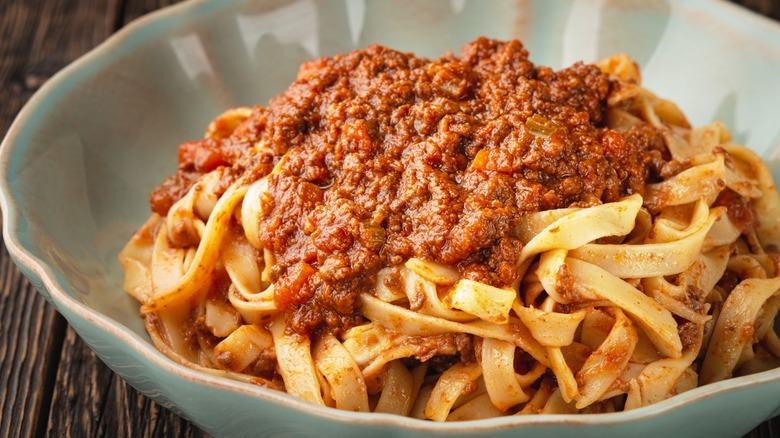What's The Difference Between Tomato Sauce And Tomato Paste?
When it comes to the sassy saucy world of juicy vine-ripened tomatoes, there is a dazzling spectrum that flows from its simplest form (fresh pulverized tomatoes) to its most sophisticated — classic ragu alla Bolognese. In between lies myriad sauces — not the least of which is a duo of foundational tomato-based sauces known as tomato sauce and tomato paste. In fact, on your way to the perfect Pomodoro, garlicky marinara, or meaty spaghetti sauce, you'll find these foundational sauces forming the base for every one.
And while many of us think of tomato sauce as the starting point, that kind of basic blank slate upon which to build a variety of our favorite tomato-focused sauces and dishes, commercially sold tomato sauce is not quite as blank a slate as one might assume and can contain a lot more than just salt, onion, or garlic.
Tomato paste, on the other hand, though thicker, is a more pure end-product containing just de-seeded, skinned, and blended tomatoes. Though these two have much in common, it's important to know the differences in how they're made, what they contain, and how they're used to decide which is best suited to your needs or how best to substitute one for the other in a pinch.
What is tomato sauce?
Canned or jarred tomato sauce starts with fresh tomatoes or tomato purée (often called tomato passata). These tomatoes are cooked, deseeded, skinned, and strained before adding additional ingredients. Once this process is complete, additions like water, salt, onion and garlic powders, sea salt, and citric acid are commonly used. However, many brands also include other herbs or spices, such as basil or oregano. Some popular household brands even include sugar, corn syrup, olive oil, carrot fiber, and even dehydrated bell pepper. It's essential to read the ingredient label carefully when choosing a sauce to ensure it will suit your needs.
While homemade tomato sauce also starts with fresh or canned tomatoes or tomato purée, it often includes chopped, sauteed onions and/or garlic. Marcella Hazan's tomato sauce recipe in the "Essentials of Classic Italian Cooking" famously includes only the addition of a single halved onion and some butter to canned San Marzanos for an incredibly easy-to-make, delicious-to-eat tomato sauce that will leave you craving it again and again. Depending on your sauce inclusions, flavor balance, and acidity, your homemade tomato sauce can be used directly on pasta, as Hazan's is for a paired-down beauty-in-its-simplicity pasta sauce or built upon as a key ingredient in everything from creamy roasted red pepper tomato soup to a luscious marinara or a one-skillet chicken cacciatore.
What is tomato paste?
Deeply colored and richly flavored, tomato paste (packed in cans and tubes) is a condensed version of tomato purée containing only tomatoes. Thick, sticky, and paste-like, tomato paste results from its water content being reduced by about half through evaporation.
Its dense tomatoey umami packs a punch and is often used to fortify flavors in substantial dishes like meatloaf, chili, and Mafé, a Senegalese peanut stew. Used in small or large quantities to enliven a variety of dishes like beef stew, where it both deepens the flavor and aids in thickening, or in dishes like stroganoff or lamb curry, where a smidge can help pump up the savory in dishes you might not assume have tomato in them.
The real key to harnessing the power of tomato paste in any dish, though, is caramelization. If you add a daub of paste to your dish without browning it first, you'll miss out on the very best of what tomato paste has to offer. To bloom your tomato paste to its fullest expression, sautee your onions, garlic, and spices in oil. Once they're ready (onions translucent and soft), add your tomato paste, spreading it thinly on the bottom of your pan, and watch as it quickly deepens in color to a dark maroon, taking care to move it around the pan as it browns. Once your paste has been patinaed, remove it or add other ingredients to the pan before it blackens.
Can you substitute tomato paste and tomato sauce for one another?
Yes — you can substitute these foundational players for one another when making tomato-based sauces in everything from fire-roasted shakshuka to tomato-based soups like spicy seafood cioppino and dishes like Mexican rice.
But before you do, it's a good idea to consider their differences. This will guide you in adapting what you have into what you need. First, tomato sauce has a greater water content than tomato paste and additional seasonings that are not present in tomato paste's unadulterated product. Depending on the sauce brand, you may need to counter some flavors or sweetness when subbing sauce for paste and reduce its water content. To convert sauce to paste, simmer your sauce in a pan, stirring constantly to avoid scorching until it's reduced by half and the sauce has thickened to paste consistency.
To adapt tomato paste, you'll need to add water in a 1-to-1 ratio to bring this intensely flavored concentrate back to the realm of sauce. Then, zhuzh it up with a few basic seasonings like onion and garlic and salt to bring it up to the level of basic tomato sauce before layering in any other ingredients. You may also need to adjust the acidity or sweetness of your sauce with baking soda, vinegar, or sugar to balance your result. A small amount of oil or butter can also help smooth things out.
How are tomato sauce and paste different from other red sauces?
The main thing to note is that sauce, and paste are both bases upon which you can build the richest sauces. They're just different starting points but starting points nonetheless. On the other hand, pasta, pizza, marinara, and other red sauces are finished products tailored for different purposes. But that doesn't mean there isn't some overlap. For example, Hazan's tomato sauce is delectable as a pasta sauce, especially when prepared using the mantecare technique and topped with a fresh grating of nutty Parmesan.
Pizza sauce is thicker than pasta sauce or marinara because it starts with tomato paste, amended with the addition of spices, and slightly diluted with either water, tomato puree, or tomato sauce. Often described as "uncooked" (as it hasn't been long-simmered like pasta or marinara sauce), you can whisk the ingredients for pizza sauce together in a bowl before spreading it directly on your dough, letting the sauce cook in the oven. Pasta sauce, marinara, and other red sauces, on the other hand, are slow-simmered to mellow the acidity of the tomatoes in the heat and allow the garlic, onion, spices, and even meaty flavors to meld into the sauce more thoroughly.
At the heart of all these variations sits the tomato — a small, round, red fruit with so many pasta-bilities. Knowing the idiosyncracies of these foundational sauces can assist you in exploring its magical world on your terms. Mangia!
